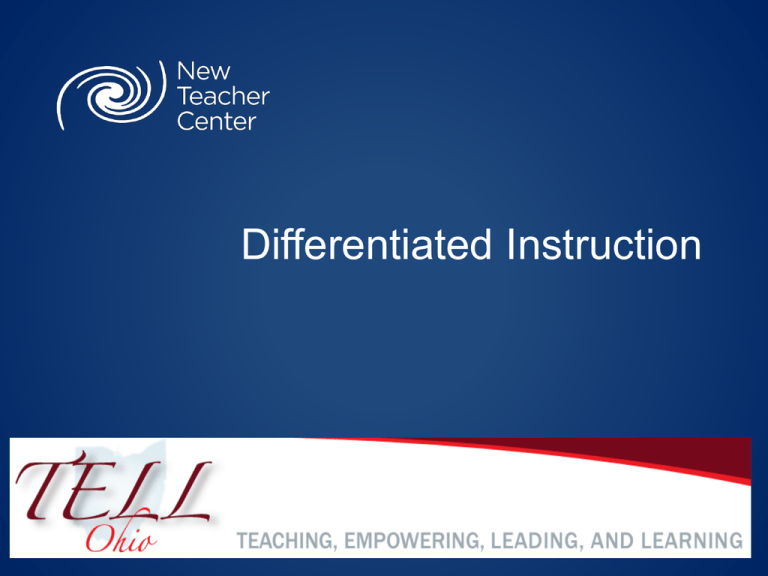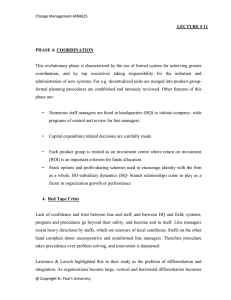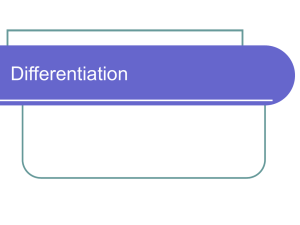
Differentiated Instruction
Blackboard Collaborate
Communication Tools
Copyright © 2011 New Teacher Center. All Rights Reserved.
Collaborate Tools
Sliders adjust mic and speaker volume
Press to Talk and activate Video
Participant Tools:
Emoticons
Step Away
Raise Hand
Polling
Chat Tool
Copyright © 2011 New Teacher Center. All Rights Reserved.
Participant Features
Audio Setup Wizard
Audio Setup Wizard
Audio & Video Settings
Copyright © 2011 New Teacher Center. All Rights Reserved.
Testing the Audio Setup Wizard
Copyright © 2011 New Teacher Center. All Rights Reserved.
Participant Features
Audio & Video
Keep the Talk and Video off
when not speaking.
Volume Controls
Video Preview
Video On and Off
Talk On and Off
Copyright © 2011 New Teacher Center. All Rights Reserved.
Questions?
① Please raise your
hand.
② Wait to be called on.
③ Turn on Talk (and
Video!) button.
④ Ask your question.
⑤ When done, please
turn off Talk button.
Copyright © 2011 New Teacher Center. All Rights Reserved.
Copyright © 2011 New Teacher Center. All Rights Reserved.
Connections to Survey Results
Survey
Item
Q8.1k
Q8.2c
Question
Professional development enhances teachers' ability to implement instructional strategies
that meet diverse student learning needs.
In which of the following areas (if any) do you need professional development to teach your
students more effectively? Differentiating instruction
Q2.1f
Teachers have sufficient instructional time to meet the needs of all students.
Q3.1a
Teachers have sufficient access to appropriate instructional materials.
Q3.1b
Teachers have sufficient access to instructional technology, including computers, printers,
software and internet access.
Q3.1h
The physical environment of classrooms in this school supports teaching and learning.
Q6.1b
Teachers are trusted to make sound professional decisions about instruction.
Q7.1h
Teachers receive feedback that can help them improve teaching.
Q8.1l
Professional development enhances teachers' abilities to improve student learning.
Q8.3c
In the past 2 years have you had 10 clock hours or more of professional development in any
of the following areas? Differentiating instruction
Q9.1f
Teachers are encouraged to try new things to improve instruction.
Q9.1h
Teachers have autonomy to make decisions about instructional delivery (i.e. pacing,
materials and pedagogy).
Objectives
• Examine 5 key components of
differentiation as defined by Carol Ann
Tomlinson
• Consider strategies to utilize the 5
components of differentiation
• Deepen the understanding of the role of
assessment in differentiation
• Explore the potential of the Knowing
Students tool to support differentiation
Forum Norms
Use chat freely
Provide feedback often
Raise hand to speak
State name before speaking
Turn off microphone
Refrain from multi-tasking
Copyright © 2011 New Teacher Center. All Rights Reserved.
What is Differentiation?
Differentiation can be defined as a way of
teaching in which teachers proactively
modify curriculum, teaching methods,
resources, learning activities, and student
products to address the needs of individual
students to maximize the learning
opportunity for each student in the
classroom.
Carol Ann Tomlinson
How does the definition of
differentiation offered by
Carol Ann Tomlinson align
with your view of
differentiation?
Use the chat box on the left side of the screen to respond
to the prompt above.
Five Key Components of
Differentiation
Pre-Assessment
Five Key Components of
Differentiation
Environment
Five Key Components of
Differentiation
Content / Standard
Five Key Components of
Differentiation
Process / Strategies
Five Key Components of
Differentiation
Product / Assessment
Five Key Components of
Differentiation
Pre-Assessment
Environment
Content / Standard
Process Strategies
Product / Assessment
Using various preassessment tools to learn
about learners’
backgrounds, interests,
learning styles, attitudes,
learning preferences,
academic readiness
levels, and skills. This is
followed by using preassessment data to
design instruction that
meets the needs of
various learners.
Modifying the classroom
learning environment in
order to increase students
learning.
Content is the input of
teaching. What you teach
can be adapted. How
students are given access
to what you teach can also
be adapted. Content
differentiation involves
choosing content and
making it accessible to
students via students’
needs readiness levels,
interests and learning
profiles.
When students encounter
new ideas, information, or
skills, they need time to
run the input through their
own filters of meaning.
Process differentiation
involves using varied
teaching strategies and
activities to help students
make sense of new
content, skills, and ideas.
Providing different types of
assessments or choices
on assignments.
Individuals and/or groups
can then show evidence
of learning via different
products or performance
assessments.
Name that Component
Scenario
1. At the end of the unit, students choose how they will
share what they have learned about sign language. All
activities measure the same standard, but offer varying
means for students to show they met the standard.
2. As the teacher allows students to practice new
learning via guided practice, students share how to solve
a math problem using the method of their choice: in
writing, verbally, individually, in partners, with graphic
organizers …
3. At the beginning of school, the teacher gathers
information about her students via surveys, portfolios,
interviews, journals and learning logs.
4. The teacher notices that some students need to move
often. In response, he paces classes activities to allow
kinesthetic learners to move more often. Other types of
learners are also provided options that meet their
learning modality needs.
5. During guided practice on fossils the students are in
three distinct groups. Some students are in teams to
sort and classify fossils from a text activity. Others are
writing stories entitled “My Rock’s Life.” A third group are
preparing oral presentations using an interview format
about the life history of a celebrity rock.
6. Students use choice boards by selecting an activity
card from a row of pockets while other students work in
PreAssessme
nt
Environ
ment
Content
Proces
s
Product
Group Discussions
• You will be placed in discussion group linked to
one of the 5 Components of Differentiation
1. Pre-Assessment
2. Environment
3. Content / Standard
4. Process / Strategies
5. Product / Assessment
• In your group discuss strategies that you can
use to support the capacity of your teachers to
understand and apply your assigned component
of differentiation
• Identify a reporter in the group to provide a oneminutes synopsis of the group’s thinking
Five Key Components of
Differentiation – Order of Difficulty
From the easiest to learn and apply to the
hardest to learn and apply
1. Environment
2. Pre-Assessment of Individual Students
3. Product and Assessment
4. Process (Flexible Grouping)
5. Content (Tiering)
The Critical Role of PreAssessment in Differentiation
•
Role of Readiness
–
•
Role of Interest and Choice
–
•
In a five-year longitudinal study of adolescents, students whose skills were underchallenged by
tasks demonstrated low involvement in learning activities and lessoning of concentration. Students
whose skills were inadequate for the level of the challenge required by tasks demonstrated both low
achievement and a diminished sense of self-worth.
(Csikszentmihalyi, et al., 1993)
The appropriate choice in today’s diverse classrooms is no longer, “How do I motivate students?”
Rather, it is “What motivates this particular student and how do I design work that is responsive to
these motivations?”
(Schlechty, 1977)
Role of Learning Profile
–
–
Students whose instruction matched their pattern of abilities performed significantly better than the
others. Even by partially matching instruction to abilities, student achievement improved.
When the students’ cultural differences are ignored or misunderstood in the classroom, the
academic success of students from many minority groups is likely to be undermined.
(Sternberg, 1985, 1996, 1997; Delpit, 1995)
The best question an assessment answers is:
What is next in instruction?
Grant Wiggins
Three Types of Assessments
Pre-Assessment
Formative Assessment (For
Learning)
Summative Assessment
(Of Learning)
Defined
Documenting student’s skills,
readiness, learning preferences
and styles, multiple intelligences in
order to design instruction that
meets student’s needs
Involves students in assessment
practices and a continuous flow of
information about student’s progress in
order to advance student learning and
monitor progress
Given at the end of a lesson or unit
where students demonstrate their
level of mastery in meeting
standard(s)
Place in
time
Before Learning
During learning
After learning
Primary
Users
Teachers and students
Teachers and students
Teachers, policy makers, program
planners, administrators
Student’s
Role
Demonstrate current learning
needs
Help in setting learning goals, monitor
progress toward goals, and
demonstrate progress
Demonstrate mastery of
standard(s)
Teacher’s
Role
Assess where student’s current
learning needs are in order to tap
prior knowledge and build bridges
from old to new knowledge
Transform standards into incremental
classroom targets, inform students of
targets, have students set learning
goals, involve students in the
assessment process, check for
understanding and modify instruction
Assess student’s mastery
accurately; interpret results to
parents and students; grade
performance in terms of meeting
standard(s)
Frequency
•
Assess periodically, daily, throughout
the lesson and / or unit
Assess at the end of each unit and
/ or lesson
•
Pre-assess students’
interests, skills, learning styles
at the start of the year
Pre-assess skill level and
readiness just before each
new unit begins
Knowing Students
Academic
Academic language and literacy
skills, subject matter knowledge,
skills and abilities. English
language developmental levels
What I know:
Meta-Cognitive
Study and learning skills, ability
to self- monitor behavior, selfassess, set and attain goals, and
ability to manage time
What I know:
Individual Preferences
Preferences in learning styles,
multiple intelligences, interests,
hobbies, aptitudes, emotional
intelligence
What I know:
Person Context
Socio-cultural traditions, nonschool literacies, home and
community background, primary
language, educational histories,
perceptions
What I know:
What I’m wondering:
Next steps:
What I’m wondering:
Next steps:
What I’m wondering:
Next steps:
What I’m wondering:
Next steps:
A Student’s Voice
You think that I don’t know that you think
I got an F because I am lazy and indifferent.
But maybe I am just under-challenged and under-appreciated.
Deep down I am begging you to teach me
To learn and create – not just to memorize and regurgitate.
I’m asking you to help me find my own voice.
I’m asking you to help me find my own beauty.
I’m asking you to help me find my own unique truth.
We need a miracle
One for every kid who subconsciously wants to be pushed to the edge /
taken to the most extreme limits.
I want you to make my brain work in a hundred different ways every day.
I’m asking you to make my head ache with knowledge – spin with ideas.
I want you to make my mind my most powerful asset.
10th grade student
Arlington High School, Indianapolis, Indiana
Resources
• Respectful Work and Grouping Strategies
• Research and Bibliography
• Five Key Components of Differentiation -Strategies




